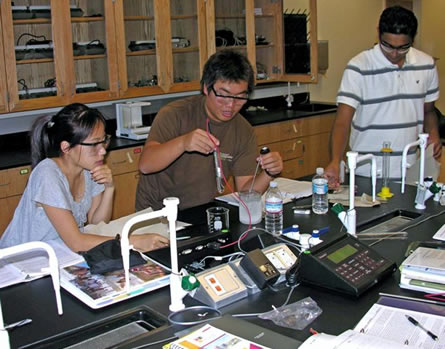
“Why do I have to learn junk I’ll never use in real life?” is arguably the most harrowing question to ever echo in a science or math classroom. For generations, an education in science, engineering or math has been mostly reserved for only those very bright students intending to pursue an advanced degree in one of those disciplines. Most of these students were white males, with strong social stigmas preventing females or students in minority groups from participating. Students who wanted to work in other professions or stay at home to raise kids often avoided science and math classes, thinking a working knowledge of these subjects unnecessary for a workaday life. Today’s fierce global economic climate does not allow modern student to cherry-pick skills to take into the workplace – even the most rudimentary jobs require a certain amount of technical sophistication and understanding of STEM subjects. While most students will not eventually work in a STEM field, they will enjoy life-long benefits from their experiences studying in a STEM-rich environment.
National Economy
A workforce well-educated in science, technology, engineering and math, or STEM, skills is now an absolute necessity to keep the United States in a competitive position in today’s global economy. According to a 2009 assessment of 15-year olds, the United States pulled a below-average ranking of 32nd in mathematics and an average rank of 23rd in science. These dismal statistics worry economists, industry leaders and politicians who recognize the power innovations science and technology has on the nation’s positions in the global markets. Knowledge is the engine that drives that innovation. Our nation needs an innovative strategy to its technical strength enough to compete in today’s global economy.
Improved Learning
One of the most obvious and innovative national strategies is to put STEM technology directly into the hands of high school students. STEM education transforms a teacher-centric classroom into a laboratory where curiosity and innovation propel discovery and learning. Cutting-edge STEM education tools replace dusty static textbooks with real-life technology. Lectures and memorization are swapped with curiosity and discovery, a more natural and long-lasting form of learning. The faces of students in an interactive STEM laboratory setting brighten as natural curiosity and inquisitiveness reawaken and reinvigorate their imaginations. The student shakes off her role as a passive learner and jumps right into the business of innovative thinking and learning. This type of exploratory thinking encourages valuable problem-solving and discovery skills students can use later in life, whether they plan to further their STEM education, go directly into the workforce or even stay at home and raise children.
Critical Thinking
Classes in STEM studies enhance critical thinking skills and require students to actively engage in a situation in order to find the solution. Students develop the same problem-solving skills in the secondary and post-secondary classroom as they will eventually use in the workplace. A savvy educator puts current technology into these students’ hands so they grow comfortable using these tools. Youngsters build STEM-specific proficiency along with critical thinking skills and familiarity with equipment as they go through secondary and post-secondary school or directly into the job market.
Increase Interest in STEM
Education in STEM studies during high school promotes interest in pursuing a post-secondary STEM degree. In a recent survey, four out of five STEM college students say they decided to study STEM while still in high school; more than half say that a specific class or a teacher, rather than a family member, got them interested in STEM subjects. This is especially true for women, with 68 percent of female students citing a teacher or a class as being the main motivation behind their decision to study STEM. Unfortunately, only one in five college STEM students say that elementary and high school adequately prepared them for college STEM courses. These students said it would have been helpful to take more STEM courses and for these courses to be more challenging.
Improved Collegiate Performance
The universities teaching advanced STEM courses would agree. One of the largest problems post-secondary institutions face is under-prepared freshmen. Universities and colleges yearn for entrants who are better educated in STEM subjects. Students entering STEM studies are woefully underprepared for collegiate courses and many students drop out before earning a degree.
Better Pay
Post-secondary STEM education results in better pay, even for workers who wind up in non-STEM positions. A person with a STEM degree will earn 13 percent more for the same job as another person without such credentials. This is especially true for women and minorities in STEM fields. While there is a gender and race gap associated with most other professions, women in STEM jobs make almost as much as their male counterparts.
The STEM skills learned in high school will serve a student well, even if she does not pursue a college degree or work in a STEM field. Even jobs in a big box store or fast food chain requires the use of hand-held electronic devices or scanners. Only repetitive, manual labor tasks do not require at least a fundamental education and the need for workers to perform this type of work has declined rapidly since the 1960s. Technology and robotics have replaced these workers with industrial machines. Today’s employers require interactive workers able to perform non-routine tasks based on a sound decision-making.
A secondary education rich in STEM studies benefits all students, whether they intend to pursue an advanced degree in the sciences or just work at the local discount store. STEM studies help students develop critical thinking skills, familiarize future workers with the equipment they will someday use and spark an interest in STEM fields. Improving secondary STEM education will improve our national workforce and enhance the way American workers do business.Discover all the learning solutions you can incorporate into your STEM laboratory.

Svante Arrhenius (1859-1927). Swedish Chemist. Lecturer and Professor at the Technical Institute in Stockholm (1891-1904). Nobel Prize Winner (1903) and later Director of the Nobel Institute (1905-1927). Arrhenius is best known for his theory of ionic dissociation, which evolved out of his doctoral thesis of 1884, his ionic acid-based definitions (1887), and his introduction of the concept of activation energy in chemical kinetics (1889). He later did pioneering work on the physical chemistry of serums, ecology (where he is responsible for much of our early understanding of the greenhouse effect), and cosmology.
Courtesy of Professor William Jensen, Oesper Chair of the History of Chemistry and Chemical Education, University of Cincinnati

Researchers expand capabilities of miniature analyzer for complex samples
(PhysOrg.com) -- It’s not often that someone can claim that going from a positive to a negative is a step forward, but that’s the case for a team of scientists from the National Institute of Standards and Technology (NIST) and private industry. In a recent paper,* the group significantly extended the reach of their novel microfluidic system for analyzing the chemical components of complex samples. The new work shows how the system, meant to analyze real-world, crude mixtures such as dirt or whole blood, can work for negatively charged components as well as it has in the past for positively charged ones.

Chemists Identify New Way to Create Photovoltaic Devices
(PhysOrg.com) -- A promising new polymer-based method for creating photovoltaic devices, which convert sunlight into electricity, has been identified by chemists at the University of Massachusetts Amherst. Their new technique should lead to more efficient power production than achievable by the current generation of semiconductors.